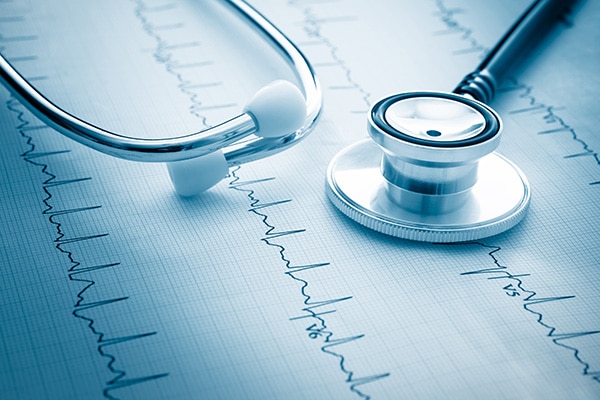
Often when a patient is referred to a cardiologist, an electrocardiogram (EKG or ECG) is also required. But don’t worry, this test is not hard to do and it won’t hurt. So what is an EKG exactly?
An EKG is a painless test that is used to record the heart’s electrical activity to look for evidence of normal or abnormal findings.
The kinds of abnormalities the EKG can show include:
- A disturbance in the heart’s rhythm (so-called arrhythmia) that is occurring at the time the EKG is being recorded
- “Footprints” that may indicate a tendency for the heart to have an arrhythmia at some point
- Evidence of abnormally thickened, strained or injured heart muscle
- Evidence of abnormally enlarged or small heart chambers
To obtain the EKG, small sticky patches (called “skin electrodes”) are placed on the chest, arms and legs in specific spots, and wires are attached to these electrodes to connect them to an EKG recording machine. When the EKG machine records the heart’s electrical activity, EKG tracings or small “squiggles” are generated. The appearance of these tracings allows the cardiologist to look for any of the abnormalities mentioned above. Please note: the EKG machine is only recording the heart’s own electrical activity, and doesn’t send electrical current from the EKG machine back to the heart or skin.
Types of EKG Tests
There are several different types of EKG tests to provide important insight regarding how your or your child’s heart is working.
- A routine or regular EKG is the most common type of EKG test, often done in a clinic, the emergency room or in the hospital. For this test, the patient removes his or her shirt so that 12-15 skin electrode patches can be placed on the chest, arms and legs. Once the patient is lying quietly, the EKG machine records the heart’s electrical activity over a very short time, usually less than one minute. The EKG technician selects the best part of that recording to generate the final EKG, a single page showing 10 seconds of the heart’s electrical activity from many different directions. This kind of EKG provides valuable information regarding the patient’s underlying heart rhythm and evidence for other important conditions such heart muscle injury, abnormal thickness of the heart muscle or size of the cardiac chambers, WPW syndrome, Long QT syndrome, and many other conditions.
- Holter monitors are used to record the heart’s rhythm for a much longer time than the routine EKG, usually for 24-48 hours. There are different types of Holters, including those with 3 to 5 skin electrode patches attached to small wires that connect to a small portable EKG recording machine (usually no bigger than a cell phone) or a single bigger patch placed on the chest without wires. The Holter records all heartbeats during different types of activities (standing, sitting, walking, exercising, sleeping, etc.), providing information about what the patient’s heart rhythm looks like during these activities rather than the short but more detailed 10-second routine EKG obtained when the patient is quietly lying down. In addition, during the Holter the patient should indicate any symptoms (palpitations, chest pain, dizziness, etc.) that are felt during the recording period by pressing a marker button on the device and noting any symptoms by selecting symptom options on the device or writing the time and type of symptoms on an accompanying diary. After the Holter recording is done, the Holter and diary must be returned either returned directly to the office or mailed back. Once returned, the Holter undergoes computer analysis, and this and the diary are sent to the cardiologist for interpretation. Once completed, the cardiologist has a lot of information such as slowest heart rate (usually when asleep), fastest heart rate (usually with physical exercise or being upset), the patient’s heart rhythm during any symptoms and any rhythm disturbances that might not even have been noticed by the patient. This analysis process can usually be completed in less than a week after the Holter and diary are returned. Results from the Holter are used by your doctor to understand you/your child’s heart rhythms to possibly recommend changes in treatment, other testing or follow-up clinic visits.
- Event recorders (EVR) are another type of EKG test used for recording the heart rhythm for longer periods. In general, these recorders look pretty similar to a Holter monitor, but instead are used to record a patient’s heart rhythms for 2-4 weeks. They can be very helpful for patients with symptoms that don’t occur every day, instead occurring less often like every few days or every couple of weeks. Another difference from Holters is that the EVR continuously records an EKG of all heartbeats, but the recordings are “forgotten” after a few minutes unless one of 2 things happen: (1) the patient (or family member) pushes an activation button to tell the EVR to “remember” or store the current EKG recording, for example when the patient has symptoms like palpitations, chest pain, dizziness or faints, and (2) when the device detects that a serious abnormal heartbeat may have occurred (even if the patient didn’t notice). After these heartbeats are recorded, they are automatically sent electronically for analysis. When your cardiologist reviews the recordings, a decision can be made regarding any recommended changes in treatment.
- Exercise EKGs can be performed in an Exercise Stress Laboratory during walking or running on a treadmill or riding a stationary bike. These EKGs are similar to the routine EKG, but give detailed information while the patient is up and exercising rather than lying quietly. Often additional information is recorded at the same time, including the patient’s blood pressure, oxygen saturation and sometimes tests of breathing (Pulmonary Function Tests).
During a stress test, the same types of skin electrode patches as used during a routine EKG are placed on the chest, arms and legs. The EKG is continuously recorded with the patient first lying down, then standing up, during the exercise part of the test, and after the test is completed over a 5-10 minute recovery phase. The EKG recordings show if the heart’s response is normal or has important changes such as an arrhythmia or evidence of excessive strain on the heart during exercise. Once the exercise part of the test is started, the patient will be asked to continue until too tired to keep going or if the patient has any concerning symptoms. Less commonly, the test will be stopped if there are significant changes seen on the EKG. In most stress tests, patients exercise for about 10-15 minutes.
Once the exercise and recovery parts of the stress test are completed, a formal analysis will be performed and reviewed by your cardiologist to decide if there are any recommended changes in treatment (for example, adjust medications, cleared to play sports, etc.).
Should I/my child take prescribed medications right before the exercise stress test? In some cases, the cardiologist will specifically ask the patient to withhold heart medication(s) on the day of the test, and in other cases the medication(s) should be taken as prescribed. This is an important decision to be made when the test is originally scheduled or at least a few days before the test, so that there’s no question on the day of the test.
Additional exercise tests: Sometimes the stress test will be combined with Pulmonary Function Testing that can evaluate for evidence of a breathing problem that might occur during exercise (for example, asthma). A comprehensive Metabolic Stress Testing involves more detailed recordings, and is used to evaluate for limitations in exercise tolerance due to impaired heart and/or lung function, possible heart failure, and physical conditioning.









